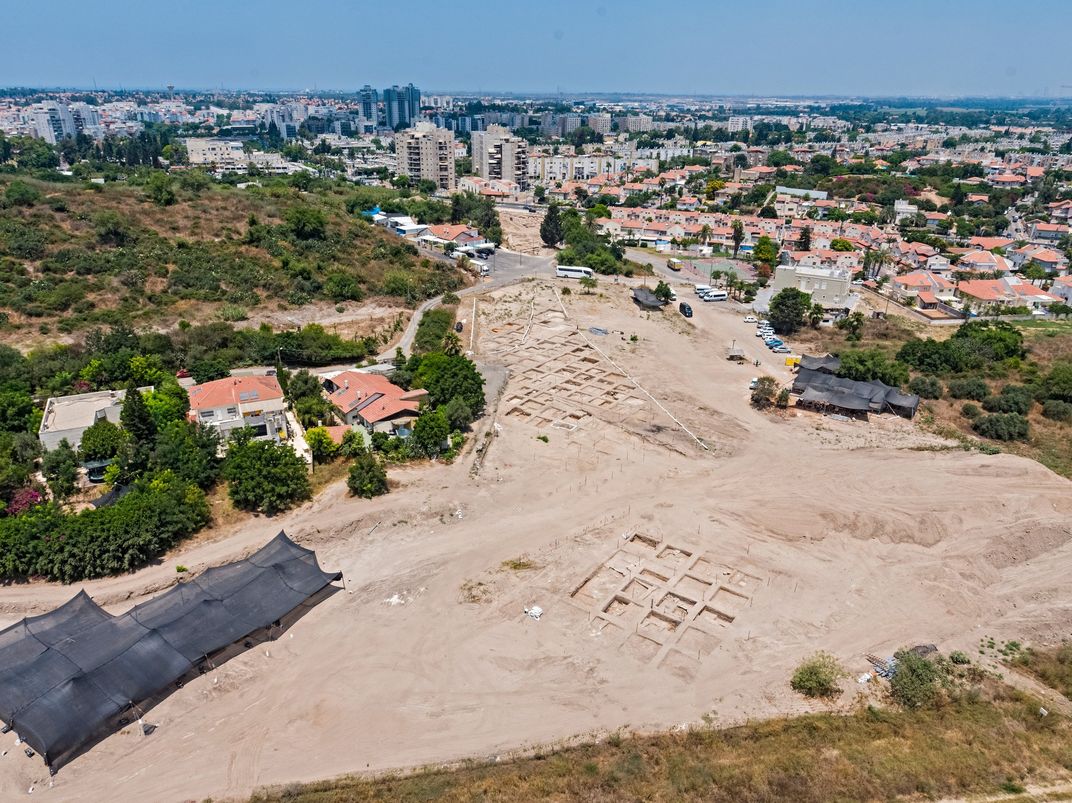Colorful, 1,600-Year-Old Mosaic Adorned With Geometric Patterns Found in Israel
The fourth- or fifth-century artwork was probably part of a large mansion near an industrial zone
:focal(480x361:481x362)/https://tf-cmsv2-smithsonianmag-media.s3.amazonaws.com/filer/eb/d7/ebd797d3-a503-41a4-8215-9b75c1cd0661/mosaic.jpg)
Archaeologists in central Israel have discovered a colorful, 1,600-year-old mosaic that may have been part of a Byzantine-era mansion.
The Israel Antiquities Authority (IAA) conducted a dig at the site ahead of new residential construction in the city of Yavne, reports Yori Yalon for Israel Hayom. The team found the geometric artwork near an ancient industrial zone.
“At first, we did not realize that the floor [was] multicolored,” say IAA archaeologists Elie Haddad and Hagit Torgë in a statement. “We assumed that it was simple white mosaic paving belonging to yet another industrial installation. But black patches dotted around the mosaic suggested that it was more than one color and prompted us to remove the whitish patina that had coated it for years.”
After cleaning the mosaic with a special acid, the scholars add, “to our astonishment, a colorful mosaic carpet was revealed, ornamented with geometric motifs.”

The researchers conclude that the mosaic floor probably belonged to a grand home in a residential area near the industrial zone.
Yavne, located about 15 miles south of Tel Aviv, was once known as Jabneh. Per Encyclopedia Britannica, it was settled by Philistines before coming under Jewish control in the eighth century B.C. After the Romans destroyed the Temple of Jerusalem in 70 A.D., the city’s academy became one of the most important scholarly centers in the Jewish world.
According to rabbinic tradition, writes Rossella Tercatin for the Jerusalem Post, Rabbi Yohanan ben Zakkai escaped Jerusalem during the Roman siege and eventually won permission from Roman Emperor Vespasian to establish a center of Torah study in Yavne. Per the Jewish Press’ David Israel, scholars at the academy preserved the Oral Torah, ensuring the survival of the laws, calendar and liturgy that form the basis of modern Judaism.
At the time of the mosaic’s creation, around 400 A.D., much of modern-day Israel was under the control of the Byzantine—or Eastern Roman—Empire. Despite sometimes facing hostile treatment from the empire’s Christian leaders, Jewish communities during this period retained their cultural institutions and local leadership structures, notes the Jewish Virtual Library.
/https://tf-cmsv2-smithsonianmag-media.s3.amazonaws.com/filer/c1/ac/c1ac40f4-bb9f-4f90-aa4c-9bc9d76296b4/177834122_615789073151909_8654749454391167704_n.jpeg)
After documenting the mosaic’s location, the researchers transferred it to an IAA facility for preservation treatment, per the Times of Israel. It will be displayed at Yavne’s cultural center as part of a joint effort by the city, the IAA and the Israel Land Authority.
“I am happy that the mosaic will be displayed in a central location in the city so that the values embodied in its heritage are preserved and made accessible to the general public,” says IAA archaeologist Diego Barkan in a separate statement from the Israel Ministry of Foreign Affairs.
As the Jewish News Syndicate reports, experts will relocate and preserve the mosaic with technological methods used in antiquity. The public will be able to observe the process firsthand.
“Archaeological preservation and awareness of the past are important values in the life of the city, which has a magnificent history,” says Yavne Mayor Zvi Gov-Ari in the ministry statement. “In an age of progress and accelerated development in all fields of life, future generations should also be able to see how the city has evolved throughout history.”
Gov-Ari adds that the city will continue to work with the IAA to provide the public with access to artifacts from the city’s ancient past.
/https://tf-cmsv2-smithsonianmag-media.s3.amazonaws.com/accounts/headshot/Livia_lg_thumbnail.png)
/https://tf-cmsv2-smithsonianmag-media.s3.amazonaws.com/accounts/headshot/Livia_lg_thumbnail.png)